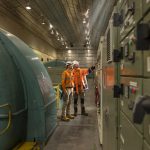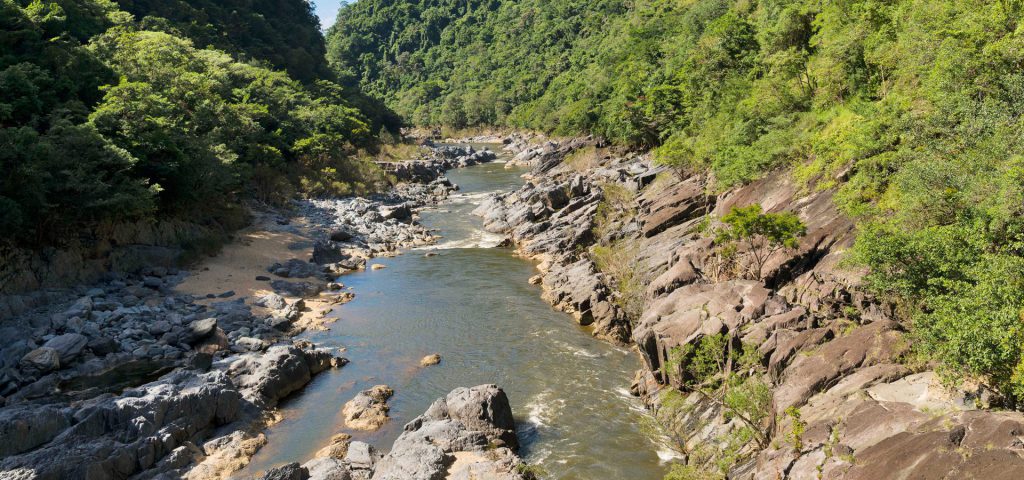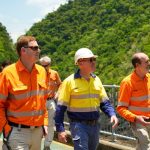Kareeya Power Station sets new generation record
Published 9 January 2025
Located in the Tully region in far north Queensland, our Kareeya Hydroelectric Power Station has been taking advantage of the high rainfall this region is famous for, to produce clean energy for more than 60 years….and the last 12 months have proved to be the station’s most productive on record!
For the 12 months to 31 December 2024, Kareeya’s four Pelton turbines generated a whopping 690,979.50MWh, setting a new station record in clean energy generation. The 2024 result surpassed the previous record of 650,540MWh, which was set in 2011.
Electricity generation starts high in the mountains above Kareeya Power Station at Koombooloomba Dam, where water from the Tully River can flow through Koombooloomba Hydro (5MW) down to Kareeya Hydro. Here it passes through four powerful 22MW generators to produce a further 88MW. After the water has been used, it is released back into the Tully River in the same pristine condition as when it entered the power station.
Kareeya Hydro does not emit any greenhouse gases and is an accredited green generator
Koombooloomba Dam started the year almost full, thanks to significant inflows from Cyclone Jasper late in 2023. Kareeya Power Station’s availability remained high throughout the year, enabling the station to generate clean energy for Queensland and achieve its new highest annual output.
Thanks to our Kareeya team, who work so hard to ensure the station is operated safely and reliably!
Learn more about Kareeya Power Station.
Wivenhoe Pumped Hydro Smashes Generation Record
Published: 27 September, 2024
- Wivenhoe Power Station has set a new generation record in Q3 2024, surpassing all previous records since its commissioning in 1984.
- The station’s two pumped hydro units have generated 199GWh since 1 July 2024, which is around 5.2 times the station’s historical quarterly average.
- Wivenhoe’s ability to store excess solar energy during the day and discharge it during peak demand in the evening and overnight demonstrates the importance of pumped hydro in Queensland’s clean energy future


CleanCo’s Wivenhoe Power Station has set a new quarterly generation record, surpassing all previous production milestones since the station began operating in 1984—and all before the third quarter of 2024 even ended.
The two pumped hydro units at Wivenhoe have generated an impressive 199GWh since 1 July 2024, exceeding the station’s historical quarterly average by more than 5.2 times. This performance highlights the increasing value of pumped hydro in Queensland’s evolving energy landscape, where renewable generation is increasing rapidly.
Wivenhoe’s capability to store excess solar energy during the day and discharge it during the evening peak and overnight has proven to be a crucial tool for balancing supply and demand. By capturing surplus solar generation and delivering it when demand is highest, Wivenhoe is putting downward pressure on electricity prices and ensuring Queensland’s electricity supply remains reliable as the state transitions to a clean energy future.
Quotes attributable to CleanCo CEO Tom Metcalfe:
“Wivenhoe is showing exactly why pumped hydro is such a powerful asset in today’s energy market. This station is playing a vital role in supporting more renewable energy in Queensland, and this new generation record underscores the importance of continued investment in clean energy solutions.
“As Queensland looks to a net zero future, CleanCo continues to deliver energy solutions that support the growth of renewable generation and ensure our customers have access to reliable, low-emission energy to support their decarbonisation journey.”
FAST FACTS
- Wivenhoe Pumped Hydro was commissioned in 1984
- Wivenhoe Power Station holds two Francis type turbines and at 285MW each, they are Australia’s largest, weighing an incredible 1,500 tonnes each.
- Wivenhoe Hydro acts like one giant rechargeable battery, with the ability to quickly generate electricity with the capacity to support up to 10 hours of continuous power generation.
CleanCo media contact – Lincoln Howe 0422 678 188 / Erin Oram 0431 089 686
Queensland’s original big battery turns 40!
Published: June 25, 2024
Wivenhoe Power Station has the capacity to power the equivalent of 125,000 Queensland homes every year.
As the station brings in its fourth decade, it remains a key player in the Queensland renewable energy landscape, with the capacity to produce a whopping 570MW.
Owned and operated by publicly owned CleanCo, the Wivenhoe Power Station plays a critical role in supporting the renewable energy transformation, using excess solar and renewable energy produced during the day to pump water up to Splityard Creek, ready for generation in the evening peak when the sun isn’t shining or when the wind isn’t blowing.
At the time of commissioning the power station, Queensland was positioned as a world leader in the use of technology to remotely control a pumped hydro station, with a start-up time of just 20 seconds.
Forty years later, its legacy and reliability remain unchanged thanks to the skilled energy workers who have safely maintained and operated the asset, so generations of Queenslanders can continue to reap the clean energy benefits.
Located in the Somerset region of south-east Queensland, the power station has played an important role in the community, providing local jobs and supporting a range of community groups and initiatives.


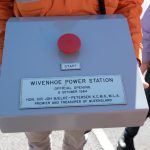

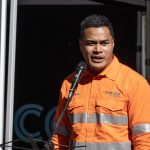

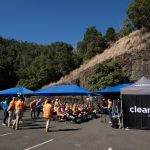
CleanCo CEO Tom Metcalfe said CleanCo is honoured to be the custodian of Wivenhoe Power Station.
“We are proud of the role Wivenhoe Power Station plays in Queensland’s energy transformation.
“With Queensland’s largest rechargeable battery in our portfolio, CleanCo is uniquely positioned to provide clean, reliable energy 24/7 – this is good for our customers, and for Queensland’s energy network.
“Our team at Wivenhoe works incredibly hard to keep the power station operating safely and efficiently – I’d like to thank each and every team member, past and present, for their valuable contributions.”
Wivenhoe Power Station Site Manager Herman Porter said the Wivenhoe team is proud to operate this unique asset in support of Queensland.
“Over 40 years, the power station has become part of the fabric of the Somerset region. It’s not only a place of employment – it’s also a place where technical capability is developed, and lifelong friendships are forged.
“Our employees are dedicated to ensuring the safe and reliable operation of the power station. Their incredible depth of knowledge and technical skill keeps Wivenhoe running smoothly.”
Former Wivenhoe Power Station Technical Officer Trevor Lush spoke of the early days at Wivenhoe.
“As Wivenhoe was the first pumped storage hydro power station in Queensland and one of only a few in Australia, we were all learning as we went – there were not too many people we could turn to for technical support, especially during the midnight hours.
“Wivenhoe was originally staffed by 5 people during daylight hours. The team gradually increased over the years to reach a level where staffing was more realistic and our capabilities increased.
“I absolutely loved working at Wivenhoe Power Station. There was a real sense of camaraderie where everyone was always willing to assist each other.”
Kuranda Weir Recovery Project
Published: 07 February 2024
Updated: 26 May 2025
When ex-Tropical Cyclone Jasper crossed the Queensland coast in December 2023, the weather system impacted many North Queensland communities and essential service infrastructure, including CleanCo’s Barron Gorge Hydroelectric Power Station.
Extremely high water levels in the Barron River caused significant damage to critical infrastructure at the Kuranda Weir which stores water required for power generation. As a result, the Barron Gorge Power Station was rendered inoperable.
Throughout 2024, CleanCo worked to successfully complete the following critical infrastructure repairs:
- Make the site safe
- Construct a temporary rock wall (coffer dam) to allow safe access to rebuild the weir embankment and enable operations to resume at the power station (Phase A)
- Resume operations at the power station
- Construct a weather resilient, permanent concrete wall to replace the earthen embankment (Phase B).
Phase A and B of the permanent rebuild at Kuranda Weir are now complete. The new concrete wall marks a significant step in strengthening the weir’s resilience and ensuring the reliability of the Barron Gorge Hydro Power Station.
With this phase of construction of the wall now complete, any safety risks associated with activities in the bed and banks of the Barron River have been resolved.
Phase C
Phase C involves design and construction of key remaining elements to complete the site.
This includes:
- stabilising additional areas of the embankment downstream of the concrete wall
- increasing the height of the Phase B concrete wall
- completing construction of all key aspects of the site for long term operations
- revegetation of the surrounds, in consultation with the Wet Tropics Management Authority
Designs for Phase C have been developed with GHD engineers and planners, early works for Phase C started in May, with ongoing work expected to continue throughout 2025, with works to be completed in 2026.
Recovery
We are working closely with authorities including the Wet Tropics Management Authority, Department of Resources and the Department of Development, Manufacturing and Water. We are also working alongside Traditional Owners, the Djabugay People, who are monitoring the project and providing cultural heritage advice.





Contact
If you have any concerns or would like more information, please contact CleanCo directly at info@cleancoqld.com.au or community@cleancoqld.com.au
Previous project updates
Celebrating 60 years of clean energy generation for one of Queensland’s oldest hydro stations
Published: 5 December, 2023
Nestled within the Wet Tropics World Heritage Area 20 km north-west of Cairns, the Barron Gorge Hydro has been a hidden yet important staple in the Cairns community for the past 60 years, giving locals a place to work close to home and thrill seekers the chance to paddle the Barron River rapids.
To commemorate the 60th Anniversary of the power station, CleanCo hosted a celebration on site bringing together past and present team members to share stories of working at one of Queensland’s oldest power stations.
A publicly owned energy asset, the Barron Gorge hydro has proudly served Queenslanders, providing a reliable and sustainable energy supply for the last six decades.
As part of CleanCo’s fleet of publicly owned clean energy generators, the Barron Gorge hydro will continue to play a critical role in shoring up a reliable, affordable clean energy future for Queensland’s industries and communities for decades to come.
Quotes attributable to Member for Barron River, Craig Crawford MP:
“Hydroelectricity is one of the oldest forms of renewable energy.
“Barron Gorge Hydro plays a very important part in the Palaszczuk Government’s Queensland Energy and Jobs Plan.
“It also supports a really great local attraction for adventure-seekers with the water discharged from the power station creating the world-famous Barron River rapids.
“Whether it’s renewable energy generation or white-water rapids, Barron Gorge hydro has a special place here in far north Queensland.”
Quotes attributable to CleanCo CEO, Tom Metcalfe:
“Far from slowing down, operations at Barron Gorge are increasingly critical to the energy transformation. This last financial year saw Barron Gorge power station generate 334,416 MWh– that’s 47.59 per cent more than the previous year and the highest generation since FY2019.
“Even more critical is that Barron’s generation can be delivered when the market needs it the most. The water resource is controllable, allowing Barron to play a vital role in backing up CleanCo’s solar and wind resources when the sun isn’t shining or the when the wind isn’t blowing.
“Barron Gorge Hydro has been operating for the last 60 years, and thanks to the hard work and dedication of the team here at Barron Gorge, we are actively planning for the next 60 years.
“That’s good news for Queensland’s energy transformation, it’s good news for the local community and it’s good news for the workers now, and into the future.”
Quotes attributable to Barron Gorge Hydro Station Electrical Apprentice, Aelira Catalina:
“There isn’t a single day where I don’t learn something new, whether it be practical knowledge or electrical theory related specifically to power generation. It feels very special to be a part of something that has such a significant history.
“The last major overhaul was done the year I was born – the modern station is as old as I am! Not only do I get to immerse myself in the electrical trade, but I am also surrounded by masses of experience in mechanical and electrical engineering, fitting and turning, control systems, and so much more.
“I have learned so much already and look forward to the next 3 years of my apprenticeship here at CleanCo.”
Long before Queensland began its renewable energy transformation, the Barron Gorge hydro station in Far North Queensland had already cemented its place supplying clean energy to generations of Queenslanders.
Overhaul works for Queensland’s largest pumped hydro
Published: 1 June, 2023
The Queensland Government has invested $17 million into major maintenance works on Wivenhoe’s 285MW Unit 2 turbine, creating 100 jobs under the Queensland Energy and Jobs Plan.
Planned maintenance is carried out every five years to ensure the long-term reliability of Queensland’s only existing pumped hydro facility.
CleanCo is being supported by a specialised workforce to undertake these works, and where possible is engaging local businesses to support the delivery of this important work.



